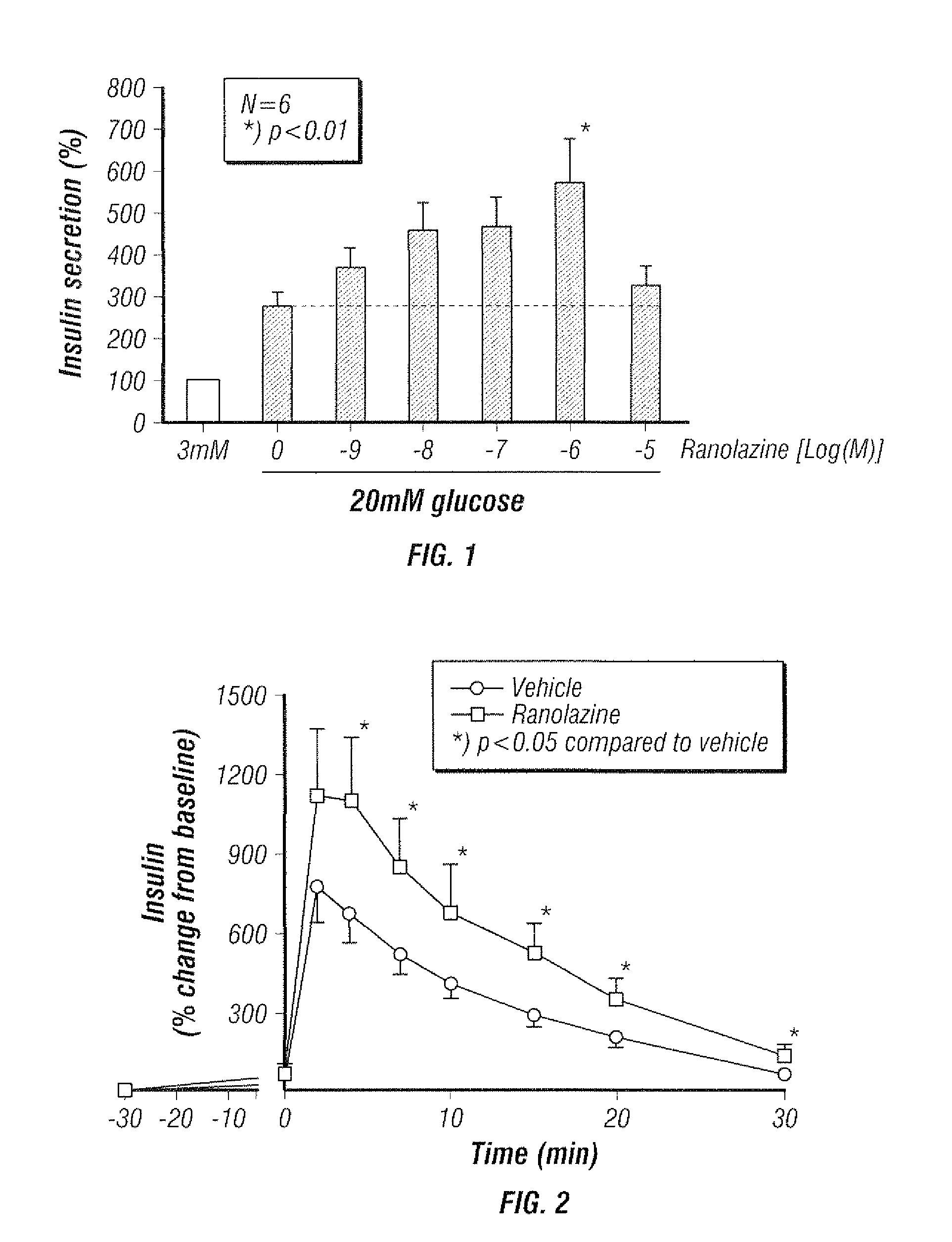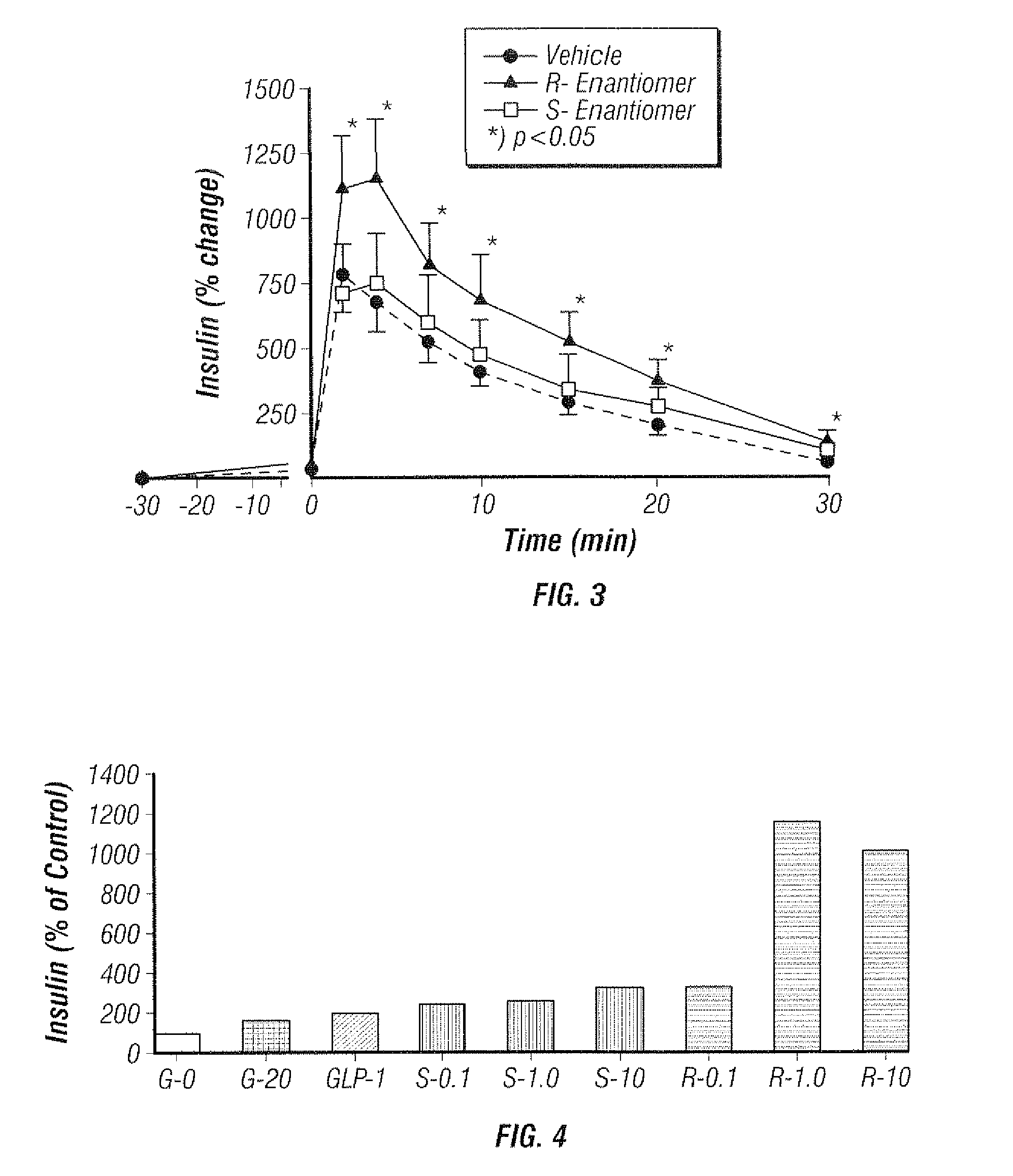Method for enhancing insulin secretion
a technology of endogenous insulin and secretion, which is applied in the field of methods for enhancing endogenous insulin levels, can solve the problems of excessively high glucose in the blood, insufficient insulin production, and inability to consume enormous amounts of food
- Summary
- Abstract
- Description
- Claims
- Application Information
AI Technical Summary
Benefits of technology
Problems solved by technology
Method used
Image
Examples
example 1
Effect of Ranolazine or the R- or S-enantiomers of Ranolazine on GSIS in rat Isolated Pancreatic Islets
[0208]FIG. 1 shows the effect of ranolazine on GSIS in rat isolated pancreatic islets. Rat islets were isolated from male Sprague-Dawley (SD) rats (8-12 weeks old, n=6) as described by Yang Z. et al. Transplantation 2004, 77, 55-60 and maintained in complete RPMI1640 overnight. Insulin secretion assay was performed essentially as previously described by Liu D. et al. Steroids 2006, 71, 691-699. Briefly, before the experiment, the islets were pre-incubated in Krebs-Ringer bicarbonate buffer (KRB; 1.29 mM NaCl, 4.8 mM KCl, 1.2 mM MgSO4, 1.2 mM KH2PO4, 2.5 mM CaCl2, 5 mM NaHCO3, 0.1% BSA, 10 mM HEPES, pH 7.4) containing 3 mM glucose for 30 min, after which islets were then washed and incubated in triplicate in 24-well plate (50 islets / well), in oxygenated KRB buffer with 3 mM glucose or 20 mM glucose in the presence of various concentrations of ranolazine or vehicle for 60 min at 37° ...
example 2
Effect of Ranolazine on Insulin Levels in Rats
[0211]FIG. 2 shows plasma insulin levels during an intravenous glucose tolerance test (IVGTT) performed in normal SD rats. Each rat was subjected to an IVGTT according to the method of Hendrick et al. Metabolism 42, (1):1-6, 1993. The rats were fasted overnight before administration of the test. One group of eleven rats was given only saline prior to glucose load while the second group of seven rats was given ranolazine prior to glucose load. Glucose was administered at time zero while ranolazine was administered 30 minutes prior to glucose at a dose of 15 mg / kg of body weight. Then, the insulin concentrations in the blood were measured at −30, 0, 2, 4, 7, 15 and 30 minutes. As seen from the plot of time versus insulin levels relative to baseline, insulin levels were higher in rats treated with ranolazine as compared to vehicle treated rats.
example 3
Effect of Ranolazine Enantiomers on Insulin Levels in Rats
[0212]FIG. 3 shows insulin levels during an intravenous glucose tolerance test (IVGTT) performed in normal SD rats. The procedure used was that described in Example 2 above. As seen from the plot of time versus insulin levels relative to baseline, insulin levels were higher in rats treated with the R-enantiomer of ranolazine at 15 mg / kg as compared to vehicle treated rats. The insulin response for the S-enantiomer was not different from the vehicle treated rats.
PUM
| Property | Measurement | Unit |
|---|---|---|
| weight | aaaaa | aaaaa |
| weight | aaaaa | aaaaa |
| pH | aaaaa | aaaaa |
Abstract
Description
Claims
Application Information
 Login to View More
Login to View More - R&D
- Intellectual Property
- Life Sciences
- Materials
- Tech Scout
- Unparalleled Data Quality
- Higher Quality Content
- 60% Fewer Hallucinations
Browse by: Latest US Patents, China's latest patents, Technical Efficacy Thesaurus, Application Domain, Technology Topic, Popular Technical Reports.
© 2025 PatSnap. All rights reserved.Legal|Privacy policy|Modern Slavery Act Transparency Statement|Sitemap|About US| Contact US: help@patsnap.com



